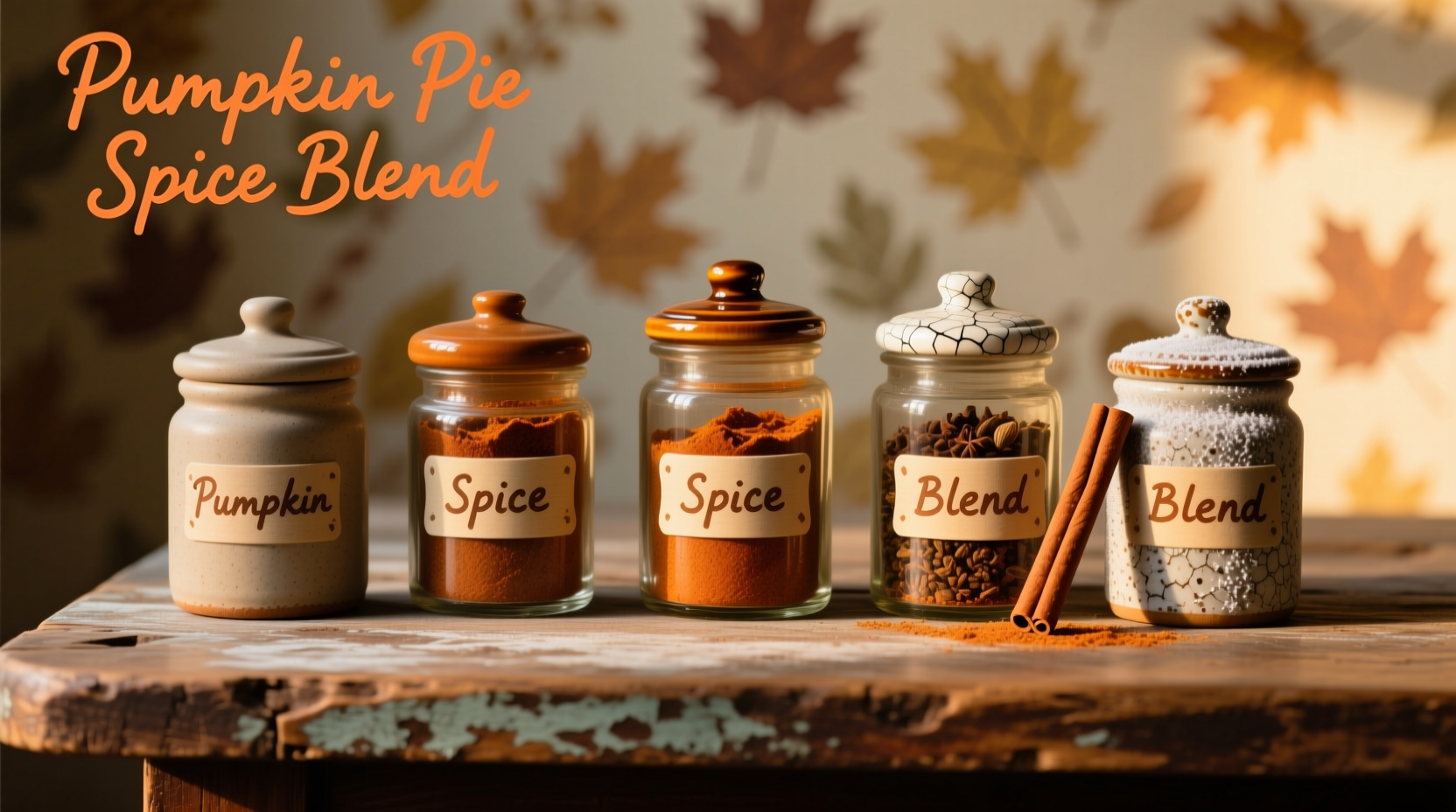The classic pumpkin pie spice blend contains five essential spices: cinnamon, ginger, nutmeg, allspice, and cloves. This standard combination creates the warm, aromatic flavor profile associated with autumn baking and seasonal desserts.
Ever wondered what gives pumpkin pie its distinctive autumnal flavor? While the name suggests pumpkin is the star, the secret lies in a carefully balanced spice blend that transforms simple ingredients into seasonal magic. Understanding exactly what spices are in pumpkin pie spice unlocks better baking results and empowers you to customize flavors to your preference.
The Evolution of Pumpkin Pie Spice
Pumpkin pie spice didn't originate with the first American colonists. Historical records show that early pumpkin preparations used whatever spices were available through limited trade routes. The standardized blend we recognize today emerged in the early 20th century as commercial spice companies sought convenience products for home bakers.
Spice Blend Development Timeline
- 1621: Pilgrims used available European spices like cinnamon and ginger with native pumpkins
- 1700s: Nutmeg and cloves became more accessible through expanding trade routes
- 1800s: Allspice gained popularity in American baking traditions
- 1930s: Commercial spice companies introduced pre-mixed "pumpkin pie spice"
- 1950s-present: Standardized ratios became consistent across major brands
Breaking Down the 5 Essential Spices
Each component in pumpkin pie spice ingredients serves a specific purpose in creating that signature flavor profile:
Cinnamon: The Foundation (70-80% of blend)
This warm, sweet spice forms the base of the blend. Ceylon cinnamon provides a more delicate flavor, while Cassia (common in North America) delivers a stronger, spicier note. Cinnamon's primary compound, cinnamaldehyde, creates that familiar comforting aroma that defines autumn baking.
Ginger: The Brightener (10-15% of blend)
Freshly ground dried ginger adds a subtle heat and citrusy brightness that cuts through the sweetness of pumpkin filling. According to spice chemistry research from the University of California, Davis, ginger's zing comes from gingerol compounds that mellow during baking into warmer, sweeter notes.
Nutmeg: The Secret Weapon (5-8% of blend)
Freshly grated nutmeg makes the most significant difference in quality. Pre-ground nutmeg loses its volatile oils quickly. The compound myristicin provides nutmeg's distinctive warm, slightly sweet flavor that enhances other spices without overpowering them.
Allspice: The Unifier (3-5% of blend)
Despite its name, allspice isn't a blend but a single berry that naturally tastes like a combination of cinnamon, nutmeg, and cloves. Native to Jamaica, it provides complexity and helps the other spices harmonize. The FDA's Spice Trade Association confirms allspice (Pimenta dioica) remains a consistent component in commercial pumpkin spice blends.
Cloves: The Accent (1-2% of blend)
Used sparingly, cloves add depth and a subtle medicinal warmth. Eugenol, the main compound in cloves, is powerful—too much creates bitterness. The American Spice Trade Association notes that quality blends use just enough to enhance without dominating.
| Spice | Commercial Blend Range | Recommended Homemade Ratio | Flavor Contribution |
|---|---|---|---|
| Cinnamon | 65-80% | 3 parts | Warm base note |
| Ginger | 10-15% | 1 part | Bright, citrusy heat |
| Nutmeg | 5-8% | 1/2 part | Sweet, nutty depth |
| Allspice | 3-5% | 1/4 part | Complex unifier |
| Cloves | 1-2% | 1/8 part | Sharp accent note |
When to Use Pre-Mixed vs. Homemade
Understanding the composition of pumpkin pie spice helps determine when to use commercial blends versus making your own:
- Use commercial blends when consistency matters for large batches or when convenience is essential
- Create your own blend when you want fresher flavor, need to adjust ratios for personal preference, or require gluten-free certification (some commercial blends use anti-caking agents)
- Avoid pre-mixed blends if you're sensitive to potential fillers—check labels as some budget brands add rice flour or other anti-caking agents

Expert Tips for Perfect Spice Application
Professional bakers follow these techniques to maximize flavor from your pumpkin spice blend ingredients:
- Bloom spices in fat: Mix spices with melted butter or oil before adding to wet ingredients—this extracts fat-soluble flavor compounds
- Toast whole spices: For homemade blends, toast whole spices before grinding (350°F for 3-5 minutes) to intensify flavors
- Add in stages: Incorporate half the spice blend into wet ingredients and half into dry for even distribution
- Balance acidity: Add a pinch of salt and 1/4 teaspoon cream of tartar to enhance spice perception
Common Substitutions and Mistakes
When working with pumpkin pie spice recipe components, avoid these pitfalls:
- Mistake: Using pumpkin pie spice as a direct substitute for individual spices in non-pumpkin recipes Solution: Only use the blend in recipes specifically designed for it
- Mistake: Substituting apple pie spice (which contains cardamom but less ginger) Solution: Add extra ginger (1/4 teaspoon per teaspoon of blend) when substituting
- Mistake: Storing spice blends in clear containers Solution: Keep in airtight, opaque containers away from heat and light to preserve volatile oils
Creating Your Perfect Custom Blend
The beauty of understanding what's in pumpkin pie spice is customization. Try these professional adjustments:
- For brighter flavor: Increase ginger by 25% and add a pinch of black pepper
- For deeper warmth: Slightly increase cloves and add a tiny pinch of mace
- For holiday complexity: Add 1/8 teaspoon cardamom to the standard blend
- For sensitive palates: Reduce cloves by half and increase cinnamon proportionally
Remember that freshness matters most—spices lose potency within 6 months. For the best pumpkin pie spice ingredients ratio, make small batches (enough for 2-3 recipes) and store in the freezer for maximum shelf life.











 浙公网安备
33010002000092号
浙公网安备
33010002000092号 浙B2-20120091-4
浙B2-20120091-4